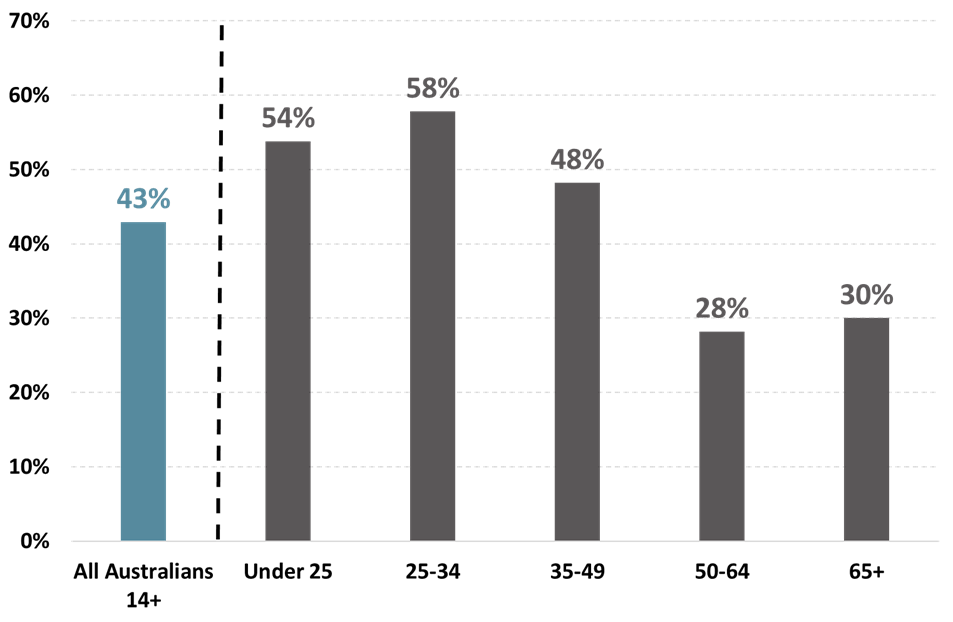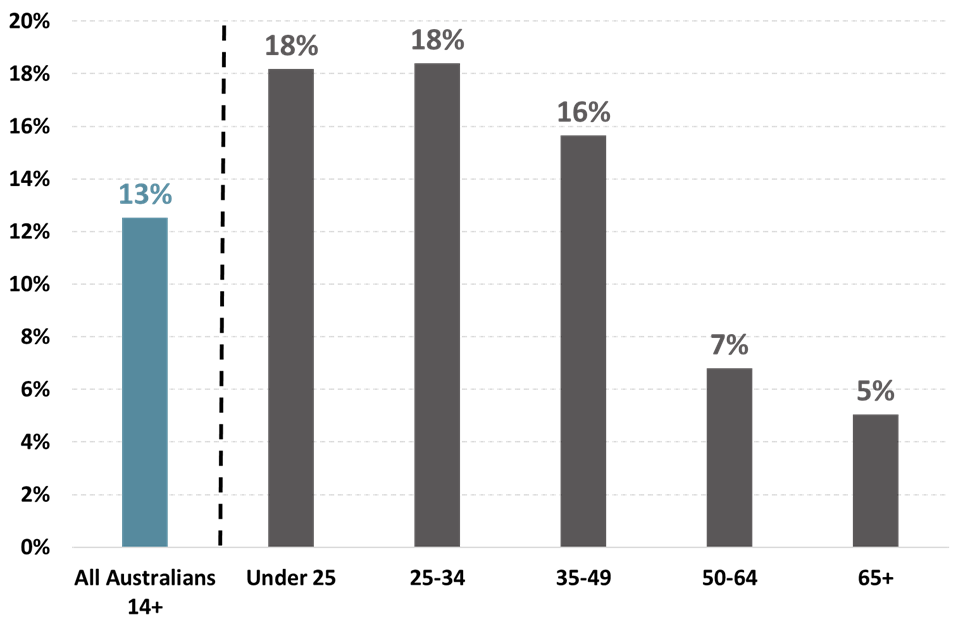Young Australians drive use of captions for films, videos and TV shows

New Roy Morgan research shows 43% of Australians now prefer to watch Films, Videos and TV shows with captions or subtitles on, 13% prefer their news/ entertainment in a language other than English, and younger Australians are far more likely to have this preference than their older counterparts.
This finding is part of a larger program of research exploring ‘Diversity and Inclusion in Media’. A nationwide cross-section of 14,969 Australian aged 14+ were interviewed between April and June 2025, and asked whether they agree or disagree with the following statements:
‘I prefer watching TV/ Films/ Videos with the subtitles or captions on’;
‘I prefer news/ entertainment in a language other than English’; and asked whether you:
‘Went to a cultural or religious festival in the last 3 months.’
Analysis by age shows a majority of Australians under 35 say they prefer to watch films, videos and TV shows with the subtitles or captions on (54% aged under 25 and 58% aged 25-34), as do 48% of those aged 35-49.
Among older Australians aged 50 and above far fewer prefer captions and subtitles. Just over a quarter of 50-64yr olds (28%) and 65+ (30%) prefer to watch Films, Videos and TV shows with the subtitles or captions on.
% of Australians prefer watching Films, Videos and TV shows with the subtitles or captions on – by age

Source: Roy Morgan Single Source, April – June 2025, n=14,969. Base: All Australians 14+.
Unsurprisingly, the preference for subtitles or captions is significantly higher for people speaking a language other than English at home. Clear majorities prefer to watch with subtitles or captions on among people speaking Mandarin (70%), Arabic (65%), Cantonese (64%), Vietnamese (63%) and Hindi (62%).
13% of Australians now prefer news/ entertainment in a language other than English
One-in-eight Australians (13%) now prefer their news/ entertainment in a language other than English.
Analysis by age shows younger Australians are more likely than their older counterparts to prefer their news/ entertainment in a language other than English.
Over 16% of Australians under 50 prefer a language other than English (18% for people aged 14-34 and 16% among those aged 35-49).
However, there is a significant drop-off for older Australians. Only 7% of people aged 50-64 and just 5% of those aged 65+ prefer their news/ entertainment in a language other than English.
% of Australians that prefer news/entertainment in a language other than English – by age

Source: Roy Morgan Single Source, April – June 2025, n=14,969. Base: All Australians 14+.
Analysing this question by ‘Country of Birth’ shows that more than a quarter of Australians born in Central and South America (38%), India (37%), China (33%) and the Middle East (27%) prefer their news/ entertainment in a language other than English.
This new Roy Morgan dataset, which examines the diverse media choices of Australians, was developed in partnership with the Media Federation of Australia’s (MFA) DE&I Advisory Council. Representing Australia’s media communications companies, the MFA worked with Roy Morgan to rethink how demographics are captured in advertising data, to better represent the full spectrum of Australia’s population.
Media Federation of Australia (MFA) CEO Sophie Madden said:

“The MFA is proud to have partnered with Roy Morgan to evolve the Single Source survey, introducing new questions that better reflect the full spectrum of Australia’s population – from cultural heritage to health conditions and neurodiversity. This modernised dataset captures the realities of our changing nation, and the first data release already demonstrates its value with sharper insights and fresh opportunities for brands to connect with diverse audiences.”
Roy Morgan’s Chief Executive Officer Michele Levine says:

“The latest research into the viewing habits of Australians confirms the way we consume TV shows, video, and movies is changing – and that change is being driven by younger Australians.
“43% of all Australians now prefer to watch TV shows/ Films/ Videos with subtitles or captions on – and clear majorities of people aged under 35 prefer captions and subtitles. In stark contrast, the rate for people aged 50 and over is only around half the level of those under 35.
“Clearly a key part of this split is due to the diverse younger population. Australian immigration policy favours skilled younger workers and in recent years the traditional migrant sources in Europe have been replaced by countries in Asia led by China and India.
“The preference for watching TV shows/ Films/ Videos with subtitles or captions is significantly higher for people born in India (72%) or China (72%) than for those migrants from New Zealand (46%), the United Kingdom and Ireland (32%) or even Mainland Europe (44%).
“Unsurprisingly, for those who speak a language other than English at home, a significant share prefer their news/ entertainment in a language other than English – and this is most pronounced for those speaking Punjabi (40%), Hindi (33%), Cantonese (32%) and Mandarin (31%) – four of the main languages spoken in India and China.
“Although just over one-in-ten Australians (11%) go to a cultural or religious festival in an average three months, this share doubles, or even triples, for those with particular religious beliefs. A majority of those of the Hindu faith (51%) attend religious or cultural festivals compared to 36% of Muslims, 33% of Pentecostals, 30% of Mormons, and 28% of Jehovah’s Witnesses.
“The changes in Australian viewing habits are clearly evolving on an ongoing basis as the underlying population of Australians also changes. The evolution in viewing habits provides Australian content creators, broadcasters and advertisers with new opportunities, and challenges, as they look for ways to reach and engage with an increasingly diverse audience.”
For comments or more information about Roy Morgan data please contact:
Roy Morgan Enquiries
Office: +61 (3) 9224 5309
askroymorgan@roymorgan.com
Reports available for sale:
The latest Roy Morgan data is available on the Roy Morgan Online Store. It provides demographic breakdowns for Age, Sex, State, Region (Capital Cities/ Country), Generations, Lifecycle, Socio-Economic Scale, Work Status, Occupation, Home Ownership, Voting Intention, Roy Morgan Value Segments, Helix Personas, Media Consumption, and more.
About Roy Morgan
Roy Morgan is Australia’s largest independent Australian research company, with offices in each state, as well as in the U.S. and U.K. A full-service research organisation, Roy Morgan has over 80 years’ experience collecting objective, independent information on consumers.
Margin of Error
The margin of error to be allowed for in any estimate depends mainly on the number of interviews on which it is based. Margin of error gives indications of the likely range within which estimates would be 95% likely to fall, expressed as the number of percentage points above or below the actual estimate. Allowance for design effects (such as stratification and weighting) should be made as appropriate.
| Sample Size | Percentage Estimate |
| 40% – 60% | 25% or 75% | 10% or 90% | 5% or 95% | |
| 1,000 | ±3.0 | ±2.7 | ±1.9 | ±1.3 |
| 5,000 | ±1.4 | ±1.2 | ±0.8 | ±0.6 |
| 7,500 | ±1.1 | ±1.0 | ±0.7 | ±0.5 |
| 10,000 | ±1.0 | ±0.9 | ±0.6 | ±0.4 |
| 20,000 | ±0.7 | ±0.6 | ±0.4 | ±0.3 |
| 50,000 | ±0.4 | ±0.4 | ±0.3 | ±0.2 |



